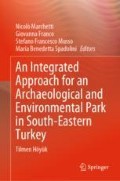Abstract
In the project conceived for the site of Tilmen Höyük, an archaeological and environmental park at the same time, the main purpose was to reinforce heritage protection whilst promoting a cultural and economic process for involving actively the local population. Designers and architects from the University of Genoa aimed at developing diverse planning scenarios, at different working scales. This multiple approach shows that heritage conservation is not a merely technical question, but a research matter with its own intrinsic value. The research group investigated the proposition of an innovative approach for designing efficient solutions in terms of products, communication and services, in which 3D renderings also played an essential role in letting the public interact with ancient remains.
(With a paragraph by Mattia Soldà and Gabriele Vescovi).
Access this chapter
Tax calculation will be finalised at checkout
Purchases are for personal use only
Notes
- 1.
Carried out in 2004–2006 and co-funded by the Italian Ministry of Education, University and Research, that project (the acronym of which was D.CULT) has seen the collaboration of seven Italian design schools based at the universities of Genoa (the author was national coordinator), Naples-Federico II, Rome La Sapienza, Palermo, the Politecnico of Milan (Departments In.D.A.Co. and B.E.S.T.) and the Politecnico of Turin. These academic institutions were joined by the Department of Geography and Human Sciences of the Environment belonging to the University of Milan, which focused on the user, with special regard to aspects of cognitive and social psychology.
- 2.
The name of the research project was Me.design Strategie, strumenti e operatività del disegno industriale per valorizzare e potenziare le risorse dell’area mediterranea tra locale e globale, also funded in 2004 by the Italian Ministry of Education, University and Research, which involved the same research units mentioned in the previous footnote and coordinated at national level by the Genoa Design School, and more specifically by the author with P. Gambaro, C. Vannicola and R. Fagnoni.
- 3.
Godoli was at the time the Director of the Dipartimento di Architettura ed Allestimenti Museografici della Galleria degli Uffizi in Florence.
References
D. Chipperfield, Common Ground, press release of the "13a Mostra Internazionale di Architettura La Biennale di Venezia," Venice (2012)
R. Fagnoni, P. Gambaro, C. Vannicola (eds.), Medesign forme del Mediterraneo (Alinea, Firenze, 2004)
A. Godoli, Beni Culturali e apporto del design. Sistema Design Italia (SDI) 03 (2006)
E. Manzini, F. Jégou, Design degli scenari, in Design multiverso. Appunti di fenomenologia del design, eds. by P. Bertola, E. Manzini (Poli.Design, Milano, 2006), pp. 189–208
F. Mitterrand, L’esempio di Chastel, inaugural address at the first edition of the Festival de l’Histoire de l’Art, Château de Fontainebleau, May 28th 2011. Il Sole 24 Ore – Domenica, 19/06/2011 (Italian translation by F. Novajra) (2011)
R. Piano, Giornale di bordo (Passigli, Firenze, 1997)
P. Pruneti, Editoriale. Archeologia Viva 125 (2007)
F. Purini, Comporre l’architettura (Laterza, Roma-Bari, 2001)
M.B. Spadolini, P. Gambaro, Il design per la valorizzazione dei Beni Culturali, in Il Sistema Design Italia per la valorizzazione dei Beni Culturali, ed. by M. Parente, E. Lupo (Edizioni Polidesign, Milano, 2009)
G. Vescovi, Contenuti complessi e tecniche rappresentative. Appunti sulle applicazioni della computer graphics per la ricerca e la divulgazione scientifica: Il caso di Tilmen Höyük in Turchia, in Proceedings of the 6th International Congress of the Archaeology of the Ancient Near East, 5 May–10 May 2009, »Sapienza« Università di Roma, vol. 3, Islamic Session – Posters Session, eds. by P. Matthiae, F. Pinnock, L. Nigro, N. Marchetti (Harrassowitz, Wiesbaden, 2010), pp. 499–508
Author information
Authors and Affiliations
Corresponding author
Editor information
Editors and Affiliations
Rights and permissions
Copyright information
© 2020 Springer Nature Switzerland AG
About this chapter
Cite this chapter
Spadolini, M.B. (2020). A Holistic Model. The Tilmen Höyük Archaeological Park Amidst Design, Conservation, Fruition and Communication. In: Marchetti, N., Franco, G., Musso, S., Spadolini, M. (eds) An Integrated Approach for an Archaeological and Environmental Park in South-Eastern Turkey. Springer, Cham. https://doi.org/10.1007/978-3-030-32754-5_4
Download citation
DOI: https://doi.org/10.1007/978-3-030-32754-5_4
Published:
Publisher Name: Springer, Cham
Print ISBN: 978-3-030-32753-8
Online ISBN: 978-3-030-32754-5
eBook Packages: Literature, Cultural and Media StudiesLiterature, Cultural and Media Studies (R0)

